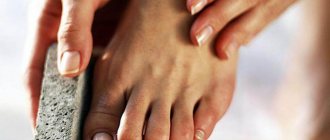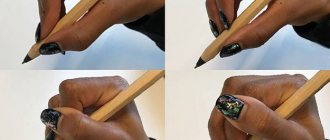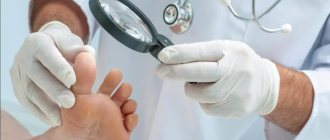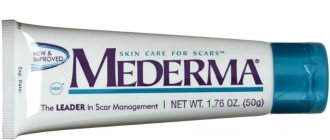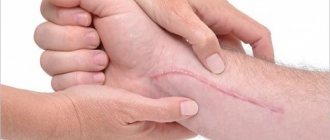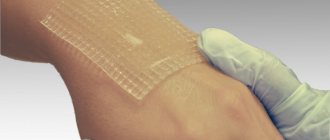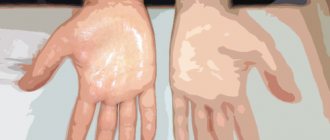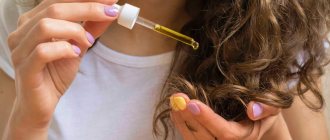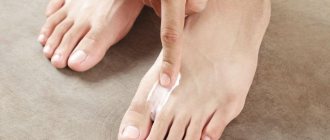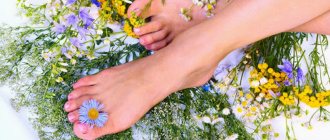What is a callus
A callus is a conical thickening of the skin that occurs in areas of constant friction or pressure. Most often, calluses appear on the feet (heel, big toe, side of the foot) and on the hands. In men, a callus may appear on the penis due to frequent wearing of too tight underwear.
The main symptom of the appearance of callous formations is the formation of tubercles of rough skin. Depending on the location and appearance, there are several types of calluses:
- dry;
- wet;
- bone.
A dry callus is a small area of thickened, dead skin that is yellowish in color. A wet callus has a thinner surface and is often filled with lymphatic fluid. Callus occurs during the process of bone regeneration after fractures. Separately, bloody calluses, core calluses, and calluses are also distinguished.
Core (root) callus is a type of dry callus and is distinguished by the presence of a thickened keratin core. The external manifestation of a root callus is similar to that of a plantar wart, so a dermatologist can make an accurate diagnosis after performing a dermatoscopy.
Calluses (corns) are wide, flat thickenings of the skin that do not have a hard center. Corns on the feet and hands rarely cause pain when pressed.
A callus with blood is a type of wet callus filled not only with lymph, but also with blood. A callus occurs when blood vessels are too close to the surface of the skin that has been subjected to friction.
Contraindications
Traditional methods of treatment cannot be used for growths with cracks, if there is a deep core, if calluses appear frequently - in all these cases, home treatment can be harmful; consultation with a doctor is required.
Non-traditional methods of therapy are good for getting rid of corns, especially at the initial stage of development. Home remedies are safe, but when using them, it is necessary to follow the dosage and procedure rules. To avoid the formation of growths, you need to wear comfortable shoes made from natural materials, regularly examine your feet, lead a healthy lifestyle, and eat right.
The material was prepared specifically for the website mazikrem.ru, edited by doctor I.A. Volkova. Specialty: family medicine, general hygiene, parasitology.
Causes of calluses
In response to constant friction and pressure, cells begin to synthesize increased amounts of keratin, the skin's protective protein. With calluses, keratin can form a plug in the deep layers of the skin. The main reasons for the formation of calluses on the feet and hands are:
- wearing shoes of the wrong size;
- foot deformities (hammer toes, bunions, bone spurs);
- chafing of the skin due to professional activities (musicians, weightlifters, artisans);
In tight shoes, the skin of the foot is strongly compressed, and in too loose shoes, it slips and rubs, which can cause internal (core) calluses to develop. Calluses on the foot due to toe deformities occur due to improper weight distribution. Due to frequent rubbing of the skin of the hands with professional instruments (strings, bars), calluses appear on the hands.
Dry and wet calluses
Dry calluses are keratinized areas of skin that form in places where bone presses on the skin of the feet (tops of the toes). If you frequently wear tight shoes, dry subungual callus may form.
Wet (water) calluses are whitish-gray in color and have a softer texture because they form in areas of increased sweating on the feet and hands. Water calluses often form between the fingers and toes. If a wet callus on the foot is damaged, an infection can enter the wound, so it is important to treat the damaged area of skin with antiseptic agents.
Precautionary measures
Various herbs and plants can cause allergic reactions in people with hypersensitivity. To avoid negative consequences, a small amount of the product should be applied to the elbow and check the reaction after 15 minutes.
Celandine should be used with extreme caution - healthy tissue should not be touched; the procedure should be carried out with gloves, since the grass is poisonous.
Each person has a different epidermis density, any folk remedy should be kept until the first unpleasant sensations appear - tingling, burning.
Callus
Callus formation is an important step in the process of bone tissue repair after injury because it helps connect the parts of the damaged bone. After a fracture, the callus is enriched with calcium and gradually turns into normal bone tissue.
Due to insufficient immobilization or poor circulation at the fracture site, callus may form too slowly (delayed fracture consolidation). Its slow formation can cause the bone to heal incorrectly and cause pain.
How to get rid of calluses?
To get rid of calluses, it is enough to temporarily eliminate activities that cause chafing of the skin. You can remove dry calluses manually: you need to steam the skin of your hands and remove rough areas using pumice. In addition, the surgeon may recommend the use of keratolytic agents, which soften the skin. You cannot remove calluses on your own with the help of keratolytics if you have diabetes or pathologies of the immune system, since after removal a wound may form through which an infection can enter the body
You should see a doctor if the callus is painful to step on or touch, as this symptom may indicate the presence of a heel spur, a calcified growth on the surface of the bone. Removal of the callus core is performed by a doctor because removing the callus at home is ineffective and unsafe.
To quickly cure a water callus and avoid its damage, it is necessary to reduce the contact of the inflamed skin with the shoes: you can put a foam insert or a cotton ball between your toes. If the water callus bursts, the doctor prescribes the use of wound healing agents with an antiseptic effect.
Callus removal is performed surgically using local anesthesia. First, the surgeon cuts off the keratin growth on the skin, and then pulls out the rod. To speed up the healing process and prevent the wound from becoming infected, it is recommended to wear a sterile dressing for several days after the callus removal procedure. The surgeon also prescribes local use of antiseptics for two to three weeks after removal of the callus.
Folk recipes
Types of effective procedures for the treatment of dry calluses on the feet are steaming baths, applications and lotions, compresses, treating problem areas with ointments and creams made from natural ingredients.
Lotions and compresses
Applications are intended for the gradual destruction of keratinized tissue, softening and disinfection of the skin. Lotions and compresses must be used after water procedures.
Remedies for dry calluses on toes
Main component
Recipe
How to use
Effect
Potato peels, flax seeds
Mix peelings from 5 tubers with 15 g of seeds and cook until soft. Drain the liquid and mash the mixture into a puree.
Apply the composition to the problem area and leave for 20 minutes.
Emollient
Lemon
Peel a thick slice
Fix, hold for a quarter of an hour
Cauterizing, disinfectant, antimicrobial
Aloe
Cut off the bottom leaf of a plant that is at least 2 years old and place it in the refrigerator for a day. Before use, cut lengthwise
Place on the keratinized formation for half an hour
Softening, disinfecting
Apple vinegar
Mix 15 ml each of water and vinegar
Soak a cotton pad or a piece of sterile bandage in the composition, secure it to the corns, and leave overnight
Eliminates pain, softens even old growths well
Bulb onions
Soak half a medium-sized onion in vinegar for a day, add 2-3 drops of tea tree oil
Apply the leaves twice a day to the affected areas, keep for 15 minutes
Loosens rough skin
Prunes
Boil the dried fruit in 180 ml of milk, cut in half
Fix on the keratinized area and leave overnight
Removes even old corns
Clay and castor oil
Add 2 tbsp to 50 ml of castor oil. l. blue clay, warm the mixture a little in a water bath
Apply the composition to the keratinized area, cover with a thin natural cloth, and leave for 20 minutes. Carry out procedures three times a week
Softening, bactericidal
To enhance the therapeutic effect of the application, it is better to fix it with cellophane, wax paper, and put on a warm sock on top.
To remove formations on your hands, you can make a compress from a clove of garlic, or apply a paste of fresh calendula leaves or dandelion juice.
Baths
Steam baths are a popular method of treating dry calluses; after water treatments, other medications or home remedies can be applied to problem areas.
The basic recipe is to add 30 ml of liquid or 30 g of grated bar soap to 4-5 liters of water; this solution softens the skin well. Additional ingredients are intended to enhance the therapeutic effect.
How to remove dry callus
Component
Recipe (amount of ingredients per 4 liters of soap solution or water)
Action
Salt
4 tbsp. l. regular or sea salt
Analgesic, exfoliating
Soda
10 tsp.
Emollient, loosens keratinized growths. After the procedure, be sure to lubricate the skin with a rich cream.
Potassium permangantsovka
At the tip of the knife, the solution should be light pink.
It slightly burns the corns, which leads to their reduction. The method is not suitable for old calluses
Starch
Use clean water, not a solution with soap, add 3-4 tbsp. l. potato starch
Softens the keratinized layers of the epidermis
Whey or sour milk
Add 850 ml of dairy product to 3.5 liters of clean water
Antibacterial, softening, suitable for removing old growths
Chamomile, St. John's wort, celandine, calendula
Pour 3 tbsp. l of one herb or collect 400 ml of water, strain after 20 minutes. Can be used as a stand-alone product or added to other solutions
Anti-inflammatory, drying
The water for the baths should be hot, but not cause severe discomfort, the duration of the sessions is 15-20 minutes. After the procedure, the skin should be wiped well, and the corns should be treated with pumice or a special nail file.
Homemade ointments and creams
External products made from natural ingredients are suitable for treating children; they are also safe for pregnant women; calluses often occur in expectant mothers.
Recipes:
1Honey and pork fat. Mix 50 g of each ingredient, carefully add 10 ml of lemon juice, 5 drops of tea tree oil. Apply the ointment to problem areas before going to bed.
2Alcohol and camphor. To 100 ml of alcohol add 30 g of camphor and chopped red pepper, 10 g of bodyaga. Apply the composition to steamed skin, rinse after 6 hours, moisturize the feet with cream. The product may cause a burning sensation.
3Chalk and lard. Mix melted lard and chalk powder in equal parts. Apply the cream morning and evening, the minimum course duration is 1.5 weeks.
4 Garlic and lard. Add 2 chopped garlic cloves to 50 g of melted lard. Spread the mixture on an oilcloth, apply it to the keratinized formation, fix it, and carry out the procedure before going to bed.
5 Egg and vinegar. Place a fresh chicken egg in a glass container, fill it completely with vinegar, and put it in a dark place for 72 hours. Mash the egg in film, combine with 50 g of natural butter, 5 ml of vinegar, mix. Apply a thick layer to the keratinized areas, fix with polyethylene for 2-3 hours, carry out sessions for a week.
6Beekeeping products. To 50 g of propolis melted in a water bath, add 30 g of wax and juice from 1 lemon. Heat the mixture for 5 minutes over low heat. Treat the growths twice a day, the product softens the skin and speeds up the healing process.
Pine resin moisturizes and softens the epidermis well; it is enough to apply it daily before bed for 10 days.
Callus or wart?
A wart is a small growth that is caused by the human papillomavirus (HPV). Calluses and warts may be similar in appearance. A wart can be distinguished by its more granular structure and location (warts can appear on any part of the body). To accurately make a diagnosis (callus or wart) and select treatment, the surgeon can conduct a dermoscopic examination and additionally prescribe a test for human papillomavirus (HPV).
